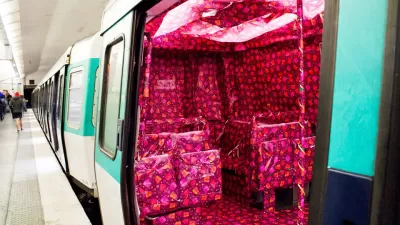A pair of recent articles examine what it’s like to use public transit every day, year after year. One examines the mechanics of on-time delivery and service—the other, the unwritten rules of ridership.

The first article, by Matt Johnson, represents a near-Herculean effort to compile a database of the author’s experiences on the Washinton D.C. Metro—the trains, their timeliness, and other anecdotal information.
“In 2013, I took 866 rides and experienced 15 delays, which means that 1.73% of my rides were delayed. In 2014, so far, I've taken 134 rides and experienced 11 delays, which means that 8.21% of my rides were delayed. That's a significant increase.”
The second article, by Nicolei Gupit, describes insights gleaned from riding the Metro bus system in Los Angeles since 1998.
“I learned by heart the cadence of passing streets as I rode the buses plying Vermont: Sunset, Fountain, Santa Monica, Melrose, Beverly, First, Third, Sixth, Wilshire. I created my own map of L.A. by surveying who got on and off the bus at which stops. While I heard mostly Spanish and Armenian spoken around East Hollywood, I would hear mostly Korean, Chinese, or Tagalog when passing neighboring areas heading south and west from home.”
FULL STORY: I tracked every Metro trip I made for two years, and here's what I found

Trump Administration Could Effectively End Housing Voucher Program
Federal officials are eyeing major cuts to the Section 8 program that helps millions of low-income households pay rent.

Planetizen Federal Action Tracker
A weekly monitor of how Trump’s orders and actions are impacting planners and planning in America.

Ken Jennings Launches Transit Web Series
The Jeopardy champ wants you to ride public transit.

Rebuilding Smarter: How LA County Is Guiding Fire-Ravaged Communities Toward Resilience
Los Angeles County is leading a coordinated effort to help fire-impacted communities rebuild with resilience by providing recovery resources, promoting fire-wise design, and aligning reconstruction with broader sustainability and climate goals.

When Borders Blur: Regional Collaboration in Action
As regional challenges outgrow city boundaries, “When Borders Blur” explores how cross-jurisdictional collaboration can drive smarter, more resilient urban planning, sharing real-world lessons from thriving partnerships across North America.

Philadelphia Is Expanding its Network of Roundabouts
Roundabouts are widely shown to decrease traffic speed, reduce congestion, and improve efficiency.
Urban Design for Planners 1: Software Tools
This six-course series explores essential urban design concepts using open source software and equips planners with the tools they need to participate fully in the urban design process.
Planning for Universal Design
Learn the tools for implementing Universal Design in planning regulations.
Ada County Highway District
Clanton & Associates, Inc.
Jessamine County Fiscal Court
Institute for Housing and Urban Development Studies (IHS)
City of Grandview
Harvard GSD Executive Education
Toledo-Lucas County Plan Commissions
Salt Lake City
NYU Wagner Graduate School of Public Service




























